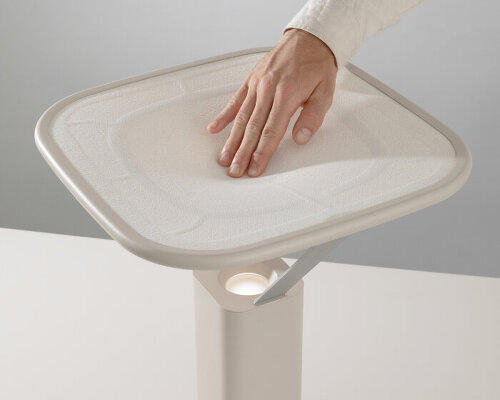Lamp with stretchable textile by WINT and Fraunhofer IZM
WINT Design Lab and the Fraunhofer IZM team up to produce a lamp that can change its brightness as the user presses onto the surface’s stretchable textile. Forming part of the research Soft Interfaces, the touch-sensitive light accessory contains a liquid metal called Galinstan embedded into the fabric. Here, the metal flows through pathways inside the textile, so when users stretch the fabric, these paths change shape, and the system reads the movement and adjusts the temperature and brightness of the lamp with stretchable textile.
The research team used Liquid Metal Dispensing technology to place the metal inside fabric. They note that this kind of process has not been used in a product before. The team – which includes Lukas Werft and Christian Dils from Fraunhofer Institute for Reliability and Microintegration IZM, as well as Robin Hoske and Felix Rasehorn from WINT Design Lab – spent one year developing the manufacturing method before they were able to produce a touch-sensitive lamp that uses liquid metal and stretchable textile to operate.
all images courtesy of WINT Design Lab | photos by Michelle Mantel
liquid metal inside knitted fabric for the lighting design
For the lamp, it is Case Studies, a Berlin knit design studio, that created the stretchable textile and other materials that WINT Design Lab and the Fraunhofer IZM used. The design studio made custom yarns for the project, making the fabric with alternating knit patterns to mark touch areas. In this way, the different surface textures help users feel the interactive zones. The textile disc is measured as a round screen, while the fabric sits inside a frame that keeps it stretched tight. The frame holds the fabric at the correct tension for touch sensing. There are four touch areas that control different light settings.
Warm light makes the fabric look like sunset colors, and the cool light makes the fabric look like morning light colors. Even the fabric color changes with the light temperature. The Fraunhofer team experimented with different fabric patterns by testing various textile structures to find the best sensing ability. The final prototype uses new manufacturing methods for liquid metal placement. The base of the lamp with stretchable textile contains all the electronic parts, from the cooling systems that keep the liquid metal at the correct temperature to the driver circuits that control the light output. The textile screen blocks direct light from the user’s eyes, allowing the reflected light to fill the room space. Then, the round disc position spreads the light evenly.
the lamp forms part of the research Soft Interfaces
Applications from car interior controls to Home textile
The teams say that the liquid metal tracks work better than conductive yarn sensors because the metal maintains electrical connection when fabric stretches. It is because of this that the system responds to gentle touch pressure. The fabric can still be washed without damaging the metal pathways. The teams see the technology being applied to different uses, including car interior controls. Home textiles could also become interactive surfaces, medical products could use the touch sensing, and HiFi systems could control volume and settings through fabric touch.
The screenless control method uses body movement instead of visual interfaces, so users feel the fabric response through their fingers. This creates a direct connection between user action and device response. The one-year collaboration between WINT Design Lab and the Fraunhofer IZM produced one working prototype lamp with stretchable textile and liquid metal. During this time, the teams also created new methods for putting liquid metal into knitted fabric. The project shows how textile materials can replace electronic touch screens, with the fabric interface using less energy than digital displays. So far, more tests are underway for the research teams’ series.
the surface has knitted fabric with liquid metal
the brightness changes as the user presses onto the stretchable textile
the metal flows through pathways inside the textile, so when users stretch the fabric, these paths change shape
detailed view of the embedded technology
detailed view of the smart home fixture
the base contains all the electronic parts
the textile screen blocks direct light from the user’s eyes
detailed view of the Liquid Metal Dispensing technology
project info:
name: Soft Interfaces
studio: WINT Design Lab | @wintdesignlab
organization: Fraunhofer IZM | @fraunhofer_izm
teams: Robin Hoske, Felix Rasehorn, Lukas Werft, Christian Dils
photography: Michelle Mantel | @michelle.mantel
The post WINT design lab co-creates lamp that changes brightness by pressing the stretchable textile appeared first on designboom | architecture & design magazine.

